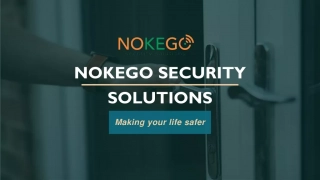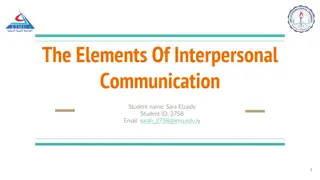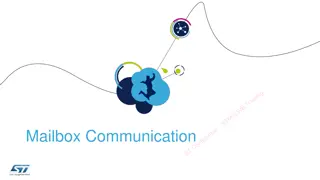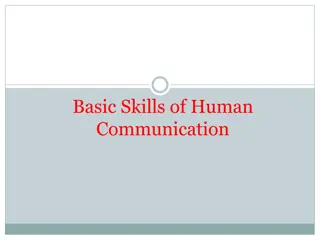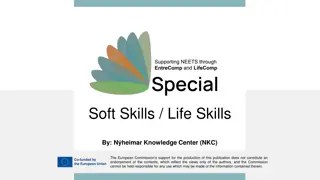PART A. 1 Communication Skills
Communication Skills encompass various methods and processes involved in how we communicate with others. Understanding the importance of clear and concise communication, exploring different methods like verbal communication, face-to-face interactions, and written communication, and recognizing the key elements of the communication process are vital for successful interaction in personal and professional contexts.
- Communication Skills
- Methods of Communication
- Verbal Communication
- Effective Interaction
- Business Communication
Download Presentation

Please find below an Image/Link to download the presentation.
The content on the website is provided AS IS for your information and personal use only. It may not be sold, licensed, or shared on other websites without obtaining consent from the author. Download presentation by click this link. If you encounter any issues during the download, it is possible that the publisher has removed the file from their server.
E N D
Presentation Transcript
PART A. 1 Communication Skills
Communication Skills means how do we communicate with each other. The way of presenting our Communication Skills include those areas which deal with our talking, writing, expressing our views. information is very important.
Methods of Communication Methods of Communication The word communication comes from the Latin word comm nic re, meaning to share . Clear and concise communication is of immense importance in work and business environment as there are several parties involved. Communication has three important parts: 1. Transmitting The sender transmits the message through one medium or another. 2. Listening The receiver listens or understands the message. 3. Feedback The receiver conveys their understanding of the message to the sender in the form of feedback to complete the communication cycle.
Communication Process and Elements Communication Process and Elements The various elements of the communication cycle are: Sender: the person beginning the communication. Message: the information that the sender wants to convey. Channel: the means by which the information is sent. Receiver: the person to whom the message is sent. Feedback: the receiver s acknowledgment and response to the message.
Methods of Communication Face-to-face informal communication e-mail Notices/Posters Business Meetings Social networks, message, phone call for communication, newsletter, blog, et Choosing the right method of communication depends on Target audience Costs Kind/type of information Urgency/priority
Verbal Communication Verbal Communication Verbal communication includes sounds, words, language, and speech. Speaking is one of the most effective and commonly used ways of communicating. It helps in expressing our emotions in words. Type of Verbal Communication Interpersonal Communication: This form of communication takes place between two individuals and is thus a one-on-one conversation. It can be formal or informal. Written Communication: This form of communication involves writing words. It can be letters, circulars, reports, manuals, SMS, social media chats, etc. It can be between two or more people. Small Group Communication: This type of communication takes place when there are more than two people involved. Each participant can interact and converse with the rest. Public Communication: This type of communication takes place when one individual addresses a large gathering.
Advantages of Verbal Communication It is an easy mode of communication in which you can exchange ideas by saying what you want and get a quick response. Disadvantages of Verbal Communication Since verbal communication depends on written or spoken words, sometimes the meanings can be confusing and difficult to understand if the right words are not used.
Mastering Verbal Communication Mastering Verbal Communication Think Before You Speak Think about your topic. Think about the most effective ways to make your listeners Understand the topic. Write or note down whatever you plan to say. Concise and Clear Speak clearly, loudly and at moderate speed. Be sure the information you want to share is to the point. Do not repeat the same sentences. Confidence and Body Language Be confident. Maintain eye contact, stand straight and be attentive. Be friendly.
Non Non- -verbal Communication verbal Communication Non-verbal communication is the expression or exchange of information or messages without using any spoken or written word. Importance of Non-verbal Communication In our day-to-day communication 55% communication is done using body movements, face, arms, etc. 38% communication is done using voice, tone, pauses, etc. only 7% communication is done using words. Types of Non-verbal Communication Facial Expressions Posture Gestures or Body Language Touch Space Eye Contact Paralanguage : tone, speed and volume of our voice.
Visual communication Visual communication proves to be effective since it involves interchanging messages only through images or pictures and therefore, you do not need to know any particular language for understanding it. Examples of Visual Communication
Communication Cycle and the Importance of Communication Cycle and the Importance of Feedback Feedback For effective communication, it is important that the sender receives an acknowledgement from the receiver about getting the message across. While a sender sends information, the receiver provides feedback on the received message. Types of Feedback Positive Feedback Negative Feedback No Feedback
A good feedback is one that is: A good feedback is one that is: Specific: Avoid general comments. Try to include examples to clarify your statement. Offering alternatives rather than just giving advice allows the receiver to decide what to do with your feedback. Timely: Being prompt is the key, since feedback loses its impact if delayed for too long. Polite: While it is important to share feedback, the recipient should not feel offended by the language of the feedback. Offering continuing support: Feedback sharing should be a continuous process. After offering feedback, let recipients know you are available for support.
Importance of Feedback Importance of Feedback It validates effective listening: The person providing the feedback knows they have been understood (or received) and that their feedback provides some value. It motivates: Feedback can motivate people to build better work relationships and continue the good work that is being appreciated. It is always there: Every time you speak to a person, we communicate feedback so it is impossible not to provide one. It boosts learning: Feedback is important to remain focussed on goals, plan better and develop improved products and services. It improves performance: Feedback can help to form better decisions to improve and increase performance.
Barriers to Effective Communication Barriers to Effective Communication What is Effective Communication? Effective communication follows the basic principles of professional communication skills. Barriers to Effective Communication Physical Barriers Physical barrier is the environmental and natural condition that act as a barrier in communication in sending message from sender to receiver. Not being able to see gestures, posture and general body language can make communication less effective. Linguistic Barriers The inability to communicate using a language is known as language barrier to communication. Language barriers are the most common communication barriers, which cause misunderstandings misinterpretations between people Interpersonal Barriers Barriers to interpersonal communication occur when the sender s message is received differently from how it was intended. Organisational Barriers Organisations are designed on the basis of formal hierarchical structures that follow performance standards, rules and regulations, procedures, policies, behavioural norms, etc. All these affect the free flow of communication in organisations Cultural Barriers Cultural barriers is when people of different cultures are unable to understand each other s customs, resulting in inconveniences and difficulties.People sometimes make stereotypical assumptions about others based on their cultural background
Ways to Overcome Barriers to Effective Ways to Overcome Barriers to Effective Communication Communication Use simple language Do not form assumptions on culture, religion or geography Try to communicate in person as much as possible Use visuals Take help of a translator to overcome differences in language Be respectful of other s opinions
Writing Skills Writing Skills Parts of Speech Parts of Speech Writing skills are part of verbal communication and include e-mails, letters, notes, articles, SMS/chat, blogs, etc. Capitalisation Rules Punctuation : Full stop, Comma, Question mark, Exclamation mark Basic Parts of Speech The part of speech indicates how a particular word functions in meaning as well as grammatically within the sentence. Some examples are nouns, pronouns, adjectives, verbs ,adverbs , Conjunctions, Prepositions, Interjections
Writing Skills Writing Skills Sentences Sentences Sentences Sentences Active and Passive Active and Passive Types of Sentences 1. Statement or Declarative Sentence 2. Question or Interrogative Sentence 3. Emotion/Reaction or Exclamatory Sentence 4. Order or Imperative Sentence
Remya traveled to Sweden from India to pursue her higher education. But she doesn't know how to speak Swedish (language of Sweden). Because of this, she was unable to find a part time job. This is an example of ____________ (a)Interpersonal barrier (b) Physical barrier (c) Organisational barrier (d) Linguistic barrier


